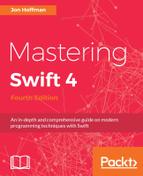Concurrency is the concept of multiple tasks starting, running, and completing within the same time period. This does not necessarily mean that the tasks are executing simultaneously. In fact, in order for tasks to be run simultaneously, our application needs to be running on a multicore or multiprocessor system. Concurrency allows us to share the processor or cores for multiple tasks; however, a single core can only execute one task at a given time.
Parallelism is the concept of two or more tasks running simultaneously. Since each core of our processor can only execute one task at a time, the number of tasks executing simultaneously is limited to the number of cores within our processors and the number of processors that we have. As an example, if we have a four-core processor, then we are limited to running four tasks simultaneously. Today's processors can execute tasks so quickly that it may appear that larger tasks are executing simultaneously. However, within the system, the larger tasks are actually taking turns executing subtasks on the cores.
In order to understand the difference between concurrency and parallelism, let's look at how a juggler juggles balls. If you watch a juggler, it seems they are catching and throwing multiple balls at any given time, however, a closer look reveals that they are, in fact, only catching and throwing one ball at a time. The other balls are in the air waiting to be caught and thrown. If we want to be able to catch and throw multiple balls simultaneously, we need to have multiple jugglers.
This example is really good because we can think of jugglers as the cores of a processer. A system with a single core processor (one juggler), regardless of how it seems, can only execute one task (catch and throw one ball) at a time. If we want to execute more than one task at a time, we need to use a multicore processor (more than one juggler).
Back in the old days when all the processors were single-core, the only way to have a system that executed tasks simultaneously was to have multiple processors in the system. This also required specialized software to take advantage of the multiple processors. In today's world, just about every device has a processor that has multiple cores, and both the iOS and macOS operating systems are designed to take advantage of the multiple cores to run tasks simultaneously.
Traditionally, the way applications added concurrency was to create multiple threads; however, this model does not scale well to an arbitrary number of cores. The biggest problem with using threads was that our applications ran on a variety of systems (and processors), and in order to optimize our code, we needed to know how many cores/processors could be efficiently used at a given time, which is usually not known at the time of development.
To solve this problem, many operating systems, including iOS and macOS, started relying on asynchronous functions. These functions are often used to initiate tasks that could possibly take a long time to complete, such as making an HTTP request or writing data to disk. An asynchronous function typically starts the long running task and then returns prior to the task's completion. Usually, this task runs in the background and uses a callback function (such as closure in Swift) when the task completes.
These asynchronous functions work great for the tasks that the OS provides them for, but what if we need to create our own asynchronous functions and do not want to manage the threads ourselves? For this, Apple provides a couple of technologies. In this chapter, we will be covering two of these technologies: GCD and operation queues.
GCD is a low-level, C-based API that allows specific tasks to be queued up for execution, and schedules the execution on any of the available processor cores. Operation queues are similar to GCD; however, they are Foundation objects and are internally implemented using GCD.
Let's begin by looking at GCD.
